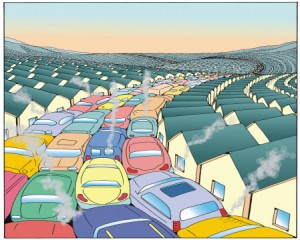Sprawl: The Health Cost
Posted on December 9, 2013 | posted by:What if we could put a human cost to our environmental impact? We’ve long known that suburban sprawl is bad for the environment. Hawken, et al. write in Natural Capitalism of the environmental evils of sprawl. The authors argue for reforming sprawl and suggest that “on a given land area, a high-density planned development could leave over half its land area as open space, and significantly reduce road and utility investments, compared with a traditional suburban layout… Adopting a New Urbanist plan instead of large-lot sprawl..reduced projected infrastructure costs by 40 percent.” (108) And yet we continue to build sprawl. How else could we convince Americans that sprawl is evil? Does knowing that it’s bad for our health make us more likely to live in urban areas? Donella Meadows would urge us to think about the best place for an intervention within a system using a leverage point. If we think about the goal of the residents who live in the suburbs, we could link their goal to be healthy and lose weight with the environmental impact.
According to the Washington Post: “People who live in sprawling communities tend to have more health problems, according to the first study to document a link between the world of strip malls, cul-de-sacs and subdivisions and a broad array of ailments. The study, which analyzed data on more than 8,600 Americans in 38 metropolitan areas, found that rates of arthritis, asthma, headaches and other complaints increased with the degree of sprawl. Living in the least sprawling areas, compared with living in the most, was like adding about four years to people’s lives, the study found.”
If we can change residents’ parameters, feedback loops, information and self-organization around the evils of sprawl, we might be able to better limit sprawl. A city or regional council could share information with its residents about the negative health effects of living in the suburbs. This in turn would encourage residents to ask for better planned suburbs, with more density and better walkability.
The best way to do this is through making the health case for consumers and the cost case for municipalities. As the authors of Natural Capitalism point out: “After the book was published, “Hundreds of exciting examples emerged from rapidly evolving business experience…But as we sifted and distilled these…we realized that the conventional wisdom is mistaken in seeing priorities in economic, environmental, and social policy as competing. The best solutions are based not on tradeoffs… but on design integration achieving all of them together…” (Page xi).
By linking the priorities in health and the environment, we can work towards citizens and cities’ goals at the same time.
Sources:
Stein, Rob, “Sprawl May Harm Health,” The Washington Post, Monday, September 27, 2004, Page A03.
Hawken, Paul, Amory Lovins, and L. Hunter Lovins, Natural Capitalism, Little Brown and Company, New York, 1999.
-Mollie West
